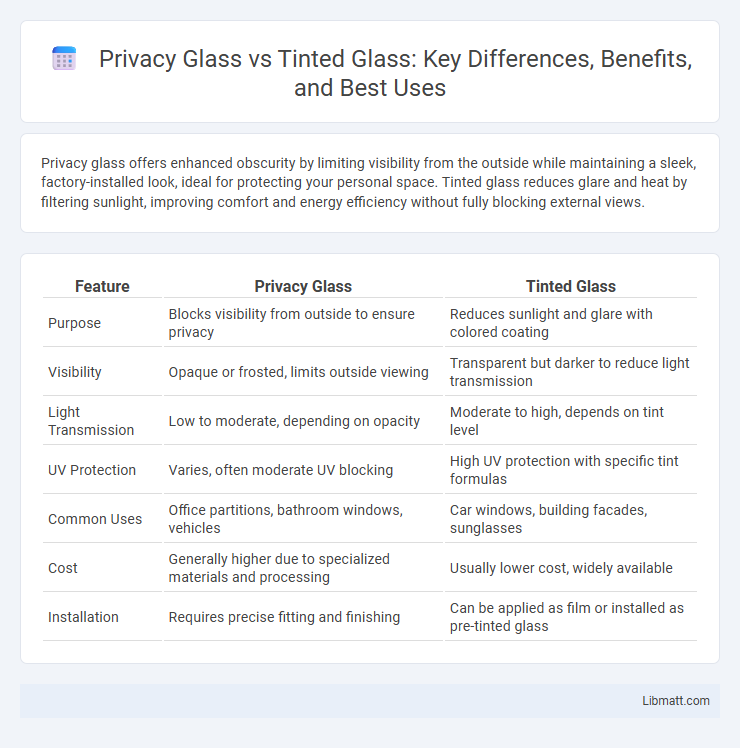Privacy glass offers enhanced obscurity by limiting visibility from the outside while maintaining a sleek, factory-installed look, ideal for protecting your personal space. Tinted glass reduces glare and heat by filtering sunlight, improving comfort and energy efficiency without fully blocking external views.
Table of Comparison
| Feature | Privacy Glass | Tinted Glass |
|---|---|---|
| Purpose | Blocks visibility from outside to ensure privacy | Reduces sunlight and glare with colored coating |
| Visibility | Opaque or frosted, limits outside viewing | Transparent but darker to reduce light transmission |
| Light Transmission | Low to moderate, depending on opacity | Moderate to high, depends on tint level |
| UV Protection | Varies, often moderate UV blocking | High UV protection with specific tint formulas |
| Common Uses | Office partitions, bathroom windows, vehicles | Car windows, building facades, sunglasses |
| Cost | Generally higher due to specialized materials and processing | Usually lower cost, widely available |
| Installation | Requires precise fitting and finishing | Can be applied as film or installed as pre-tinted glass |
Introduction to Privacy Glass and Tinted Glass
Privacy glass uses a specialized manufacturing process that incorporates a darkened or opaque layer during production, providing enhanced confidentiality by limiting visibility from outside. Tinted glass involves applying a film or coating that reduces glare and heat transmission while offering moderate privacy, primarily by darkening the glass surface. Both types improve aesthetics and comfort but differ in opacity levels and manufacturing methods, influencing vehicle security and thermal efficiency.
How Privacy Glass Works
Privacy glass works by integrating a special film or coating within the glass layers that selectively controls light transmission and visibility, allowing occupants inside to see out while obscuring the view from outside. The technology relies on varying light reflection and refraction properties, often achieved through ceramic or polymer-based tints fused during manufacturing. This differs from traditional tinted glass, which reduces visible light and heat by applying a uniform colored or reflective coating without creating a one-way privacy effect.
How Tinted Glass Works
Tinted glass works by embedding metal oxides or chemicals during the manufacturing process, which absorb and reduce the amount of visible light and infrared radiation passing through the glass. This absorption helps in minimizing glare, blocking harmful UV rays, and controlling solar heat gain, thus improving energy efficiency and comfort inside vehicles or buildings. Unlike privacy glass that darkens only when viewed from outside, tinted glass provides consistent light reduction and UV protection on both sides, enhancing visibility while offering moderate privacy.
Key Differences Between Privacy Glass and Tinted Glass
Privacy glass features a darker, often factory-installed coating that significantly reduces visibility into the vehicle's interior, enhancing security and privacy. Tinted glass primarily reduces glare and heat by filtering sunlight but offers less concealment compared to privacy glass. Understanding these differences can help you choose the option that best suits your needs for comfort and privacy.
Benefits of Privacy Glass
Privacy glass enhances your vehicle's security by limiting visibility from the outside while allowing clear vision from within, effectively protecting your belongings. It also reduces glare and blocks harmful UV rays, contributing to a more comfortable and safer driving experience. Compared to standard tinted glass, privacy glass offers superior heat rejection and maintains a sleek, uniform appearance that increases your car's aesthetic appeal.
Benefits of Tinted Glass
Tinted glass offers significant benefits including enhanced glare reduction and increased UV protection, which helps protect interiors from fading and occupants from harmful rays. It also contributes to energy efficiency by reducing heat transfer, lowering cooling costs in both residential and commercial buildings. Additionally, tinted glass provides improved privacy by limiting visibility from the outside without compromising natural light.
Privacy Glass vs Tinted Glass: Appearance and Aesthetics
Privacy glass features a darker, almost opaque look when viewed from the outside, providing enhanced privacy by significantly reducing visibility into the vehicle's interior, whereas tinted glass offers a uniform color tint that varies in shade and allows more light transmission. Privacy glass is often factory-installed, seamlessly integrated into the vehicle's design for a sleek, modern appearance, while tinted glass can be aftermarket-applied, providing customizable options in darkness and style. The aesthetic appeal of privacy glass lies in its subtle, sophisticated finish, contrasting with tinted glass's more pronounced and potentially vibrant color range.
Privacy Glass vs Tinted Glass: Security and Safety
Privacy glass offers superior security by limiting visibility into a vehicle or building, making it harder for potential intruders to see inside, while tinted glass primarily reduces glare and heat rather than enhancing concealment. Privacy glass often has a darker, factory-installed finish that is more durable and resistant to peeling compared to aftermarket window tint films, which may degrade over time and compromise safety. You benefit from privacy glass's enhanced protection without sacrificing visibility from the inside, ensuring safety while maintaining discretion.
Privacy Glass vs Tinted Glass: Cost Comparison
Privacy glass typically costs more than tinted glass due to its complex manufacturing process involving internal frosting or dyeing, which enhances opacity and privacy. Tinted glass is generally less expensive as it uses a colored film or coating to reduce glare and heat while allowing some visibility. Consumers seeking maximum privacy should consider privacy glass despite its higher price point; those prioritizing budget and UV protection often opt for tinted glass.
Choosing the Right Option for Your Needs
Privacy glass offers enhanced security by preventing outsiders from seeing inside your vehicle, making it ideal for safeguarding valuables and personal space. Tinted glass primarily reduces glare and UV exposure, improving comfort and protecting your car's interior without fully obstructing visibility. Consider your priorities--whether you want maximum privacy or UV protection--to choose the right option that best suits your needs.
privacy glass vs tinted glass Infographic

 libmatt.com
libmatt.com